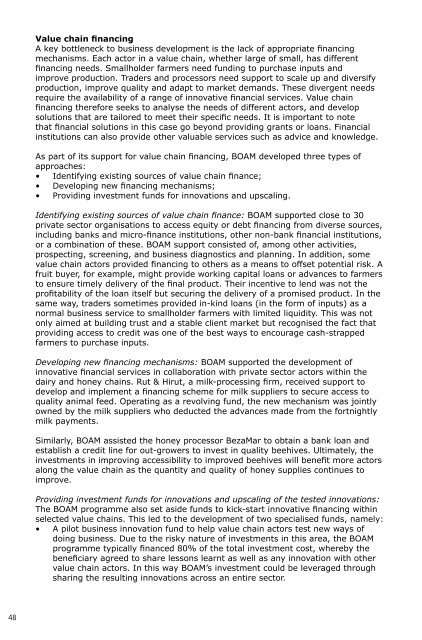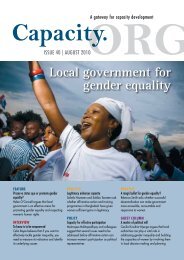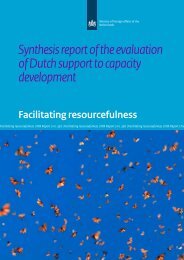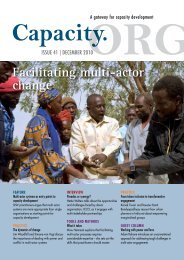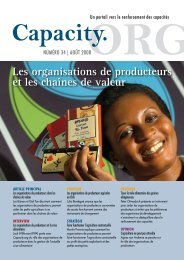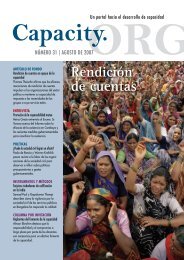Pro-Poor Value Chain Development - Capacity.org
Pro-Poor Value Chain Development - Capacity.org
Pro-Poor Value Chain Development - Capacity.org
You also want an ePaper? Increase the reach of your titles
YUMPU automatically turns print PDFs into web optimized ePapers that Google loves.
48<br />
<strong>Value</strong> chain financing<br />
A key bottleneck to business development is the lack of appropriate financing<br />
mechanisms. Each actor in a value chain, whether large of small, has different<br />
financing needs. Smallholder farmers need funding to purchase inputs and<br />
improve production. Traders and processors need support to scale up and diversify<br />
production, improve quality and adapt to market demands. These divergent needs<br />
require the availability of a range of innovative financial services. <strong>Value</strong> chain<br />
financing therefore seeks to analyse the needs of different actors, and develop<br />
solutions that are tailored to meet their specific needs. It is important to note<br />
that financial solutions in this case go beyond providing grants or loans. Financial<br />
institutions can also provide other valuable services such as advice and knowledge.<br />
As part of its support for value chain financing, BOAM developed three types of<br />
approaches:<br />
• Identifying existing sources of value chain finance;<br />
• Developing new financing mechanisms;<br />
• <strong>Pro</strong>viding investment funds for innovations and upscaling.<br />
Identifying existing sources of value chain finance: BOAM supported close to 30<br />
private sector <strong>org</strong>anisations to access equity or debt financing from diverse sources,<br />
including banks and micro-finance institutions, other non-bank financial institutions,<br />
or a combination of these. BOAM support consisted of, among other activities,<br />
prospecting, screening, and business diagnostics and planning. In addition, some<br />
value chain actors provided financing to others as a means to offset potential risk. A<br />
fruit buyer, for example, might provide working capital loans or advances to farmers<br />
to ensure timely delivery of the final product. Their incentive to lend was not the<br />
profitability of the loan itself but securing the delivery of a promised product. In the<br />
same way, traders sometimes provided in-kind loans (in the form of inputs) as a<br />
normal business service to smallholder farmers with limited liquidity. This was not<br />
only aimed at building trust and a stable client market but recognised the fact that<br />
providing access to credit was one of the best ways to encourage cash-strapped<br />
farmers to purchase inputs.<br />
Developing new financing mechanisms: BOAM supported the development of<br />
innovative financial services in collaboration with private sector actors within the<br />
dairy and honey chains. Rut & Hirut, a milk-processing firm, received support to<br />
develop and implement a financing scheme for milk suppliers to secure access to<br />
quality animal feed. Operating as a revolving fund, the new mechanism was jointly<br />
owned by the milk suppliers who deducted the advances made from the fortnightly<br />
milk payments.<br />
Similarly, BOAM assisted the honey processor BezaMar to obtain a bank loan and<br />
establish a credit line for out-growers to invest in quality beehives. Ultimately, the<br />
investments in improving accessibility to improved beehives will benefit more actors<br />
along the value chain as the quantity and quality of honey supplies continues to<br />
improve.<br />
<strong>Pro</strong>viding investment funds for innovations and upscaling of the tested innovations:<br />
The BOAM programme also set aside funds to kick-start innovative financing within<br />
selected value chains. This led to the development of two specialised funds, namely:<br />
• A pilot business innovation fund to help value chain actors test new ways of<br />
doing business. Due to the risky nature of investments in this area, the BOAM<br />
programme typically financed 80% of the total investment cost, whereby the<br />
beneficiary agreed to share lessons learnt as well as any innovation with other<br />
value chain actors. In this way BOAM’s investment could be leveraged through<br />
sharing the resulting innovations across an entire sector.


